北科大王戈:MOF基磁性相变材料用于太阳能-热能转换
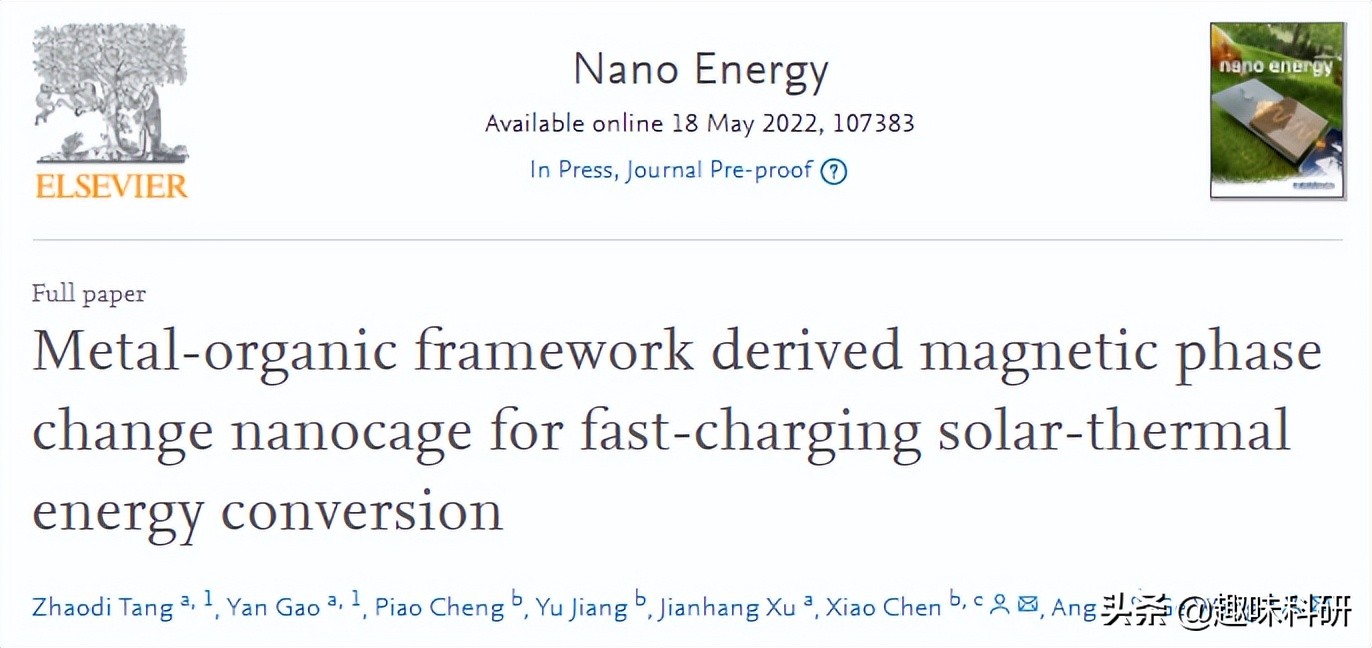
近日,北京科技大学王戈教授和北京师范大学陈晓合作在Nano Energy上在线发表研究成果,报道了一种基于MOF材料的相变材料,用于太阳能光热转换的储能系统,太阳热转换效率达到了90.7%。
【研究概要】
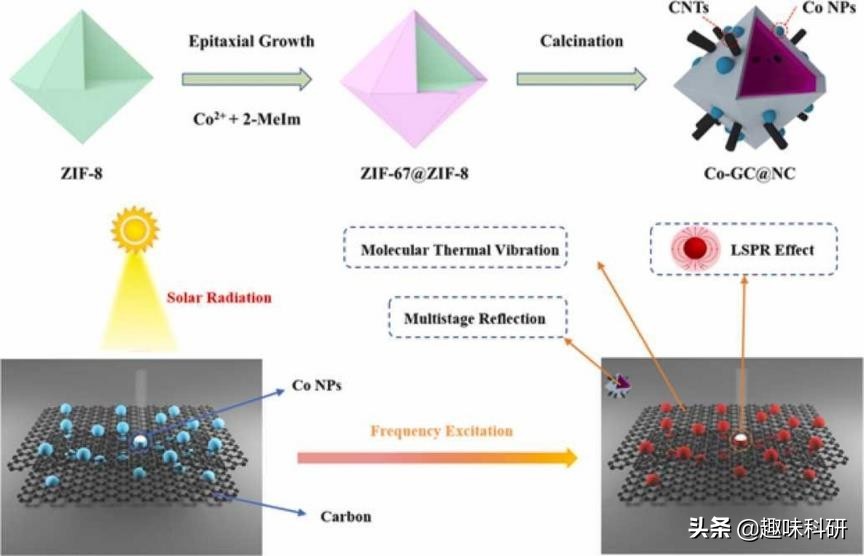
高效的太阳能捕获、转换和储存一直是面向绿色和低碳的长期追求的战略目标。然而,快速充电的太阳能热转换和可持续稳定的能量输出是目前太阳能热存储系统的主要挑战。本研究通过将相变材料(PCMs)与金属-有机框架(MOF)衍生的磁性共装饰石墨碳与氮掺杂碳(Co-GC@NC)纳米笼相结合,合理设计了一种可持续、稳定、快速充电的太阳能储能系统。得益于磁性Co纳米颗粒与GC@NC碳杂化材料的协同作用,合成的磁性碳纳米笼具有优异的全光谱吸收性能,Co-GC@NC-based复合材料PCM的太阳热转换效率高达90.7%。更引人注目的是,由于纳米笼在磁场作用下具有良好的磁操纵能力,Co-GC@NC-based复合PCM的太阳热能转换和存储效率显著提高了115.8%。同时,设计的太阳能热能转换存储系统最大输出电压为290 mV,电流为92.6 mA。这种磁性纳米笼加速策略为有针对性地建设可持续、稳定、快速充电的太阳能储能系统提供了建设性的见解。
【研究背景】
在太阳能、风能、海洋能、生物能源等各种可再生能源和绿色能源中,太阳能是满足全球日益增长的能源需求的最佳选择,已被广泛应用于光伏、水净化、光催化等多个行业。虽然太阳能很容易获得和丰富,但太阳辐射随时间、地点和天气而变化,由于其间歇性和不稳定性,不能提供持续的能源供应。因此,科学家们已作出相当大的努力,以发展有效的方法,以有效地利用太阳能。光伏技术和太阳热能转换技术是其中最重要的两种方法。前者以电能的形式储存太阳能,后者以热能的形式储存太阳能,两者都可以直接被人类利用,并且在没有太阳辐射的情况下也能提供持久的能量输出。特别是,将热能转换为电能的热电技术,利用了基于塞贝克效应的温差和利用太阳能储能的相变材料(pcm)的集成,为太阳能热能转换技术带来了更有利的潜力在冷却过程中转换并释放。首先,它可以同时提供电和热,即使没有太阳辐射也可以连续输出能量。其次,储能密度大,PCM恒温,能量输出更稳定。
然而,由于PCM或水等其他蓄热介质的太阳热能转换效率较低,很难直接收集太阳能。因此,采用多种能够有效地收获太阳能的材料来提高太阳能热能转换系统的效率。这些体系按成分主要分为碳基材料(如碳纳米管、石墨烯、膨胀石墨)、金属基材料(如Au、Ag、Co)、有机材料(如聚吡咯、聚苯胺、聚多巴胺)和其他太阳热材料(如MXene)。它们通常以载体的形式封装PCM或以添加剂的形式分散在PCM中,构建一个高效的太阳热能转换系统。碳基材料由于具有较高的太阳能吸收和转换能力,主要是由于其共振价带、导带跃迁和π-等离子体激发。例如,Qian等制备了碳纳米管(CNTs)基复合材料pcm,其太阳热转换效率高达86%。Yin等人将石墨烯纳米片均匀分散到石蜡中,形成PCM基的太阳热电池,其太阳热转换性能远优于原始石蜡。最近的研究也强调,金属材料装饰可以降低碳基材料的高发射率值,从而利用金属材料的局部表面等离子体共振(LSPR)效应进一步提高太阳热转换效率。Zhang等人通过功能化Ag NPS修饰的石墨烯纳米片稳定聚乙二醇,实现了高达92.0%的太阳能热转换效率。Feng等人制备了Co等离子体上层结构,以获得100%的太阳辐射光子捕获效率。
【图文解析】
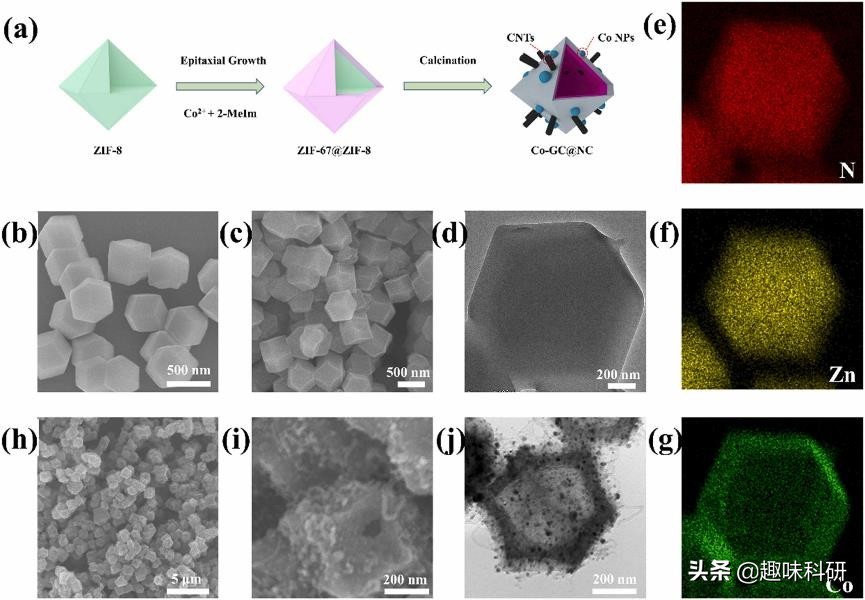
Figure 1. (a) Synthetic schematic illustration of Co-GC@NC; SEM images of (b) ZIF-8 and (c) ZIF-67@ZIF-8; (d-g) TEM images and EDS maps of ZIF-67@ZIF-8; SEM images of (h) Co-GC@NC and (i) a cracked nanocage with exposed interior; (j) TEM image of Co-GC@NC nanocage.
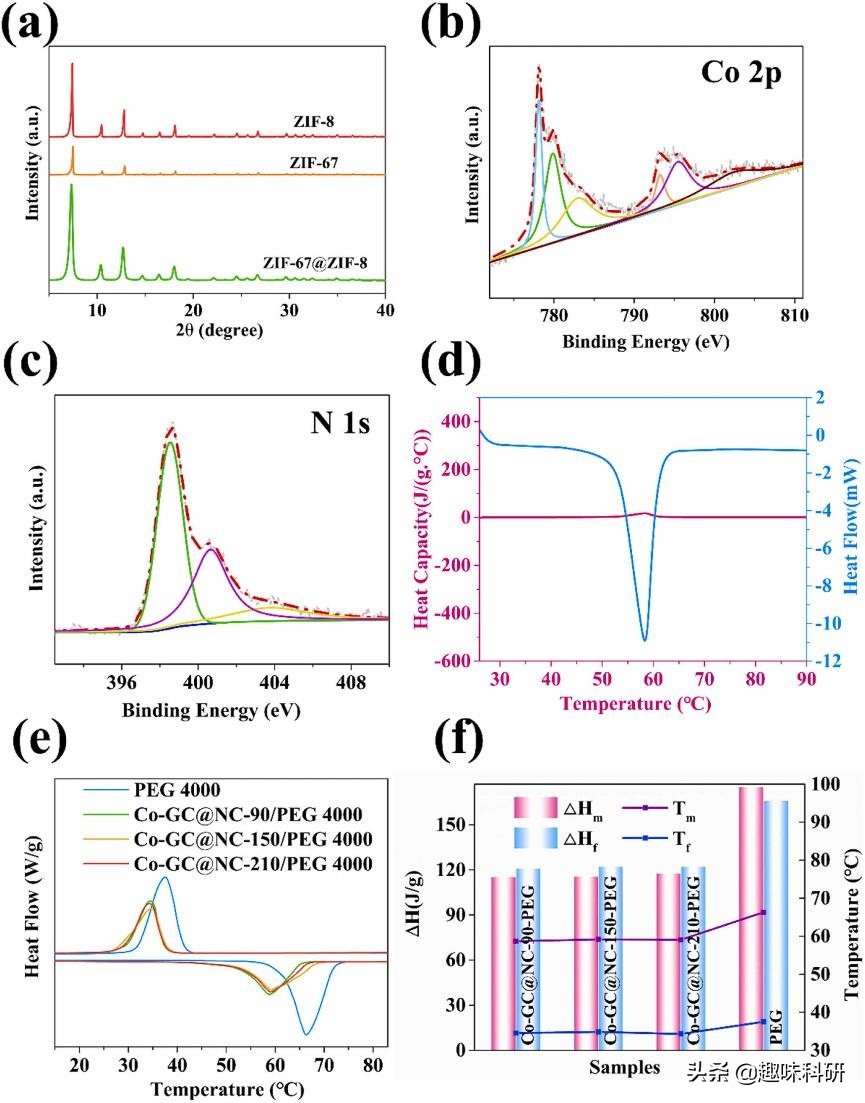
Figure 2. (a) XRD patterns of ZIF-8, ZIF-67, and ZIF-67@ZIF-8; (b-c) high-resolution XPS spectra of Co-GC@NC; (d) Specific heat capacity curve of Co-GC@NC-90/PEG 4000. (e-f) DSC curves and thermal behaviors of PEG 4000 and composite PCMs.
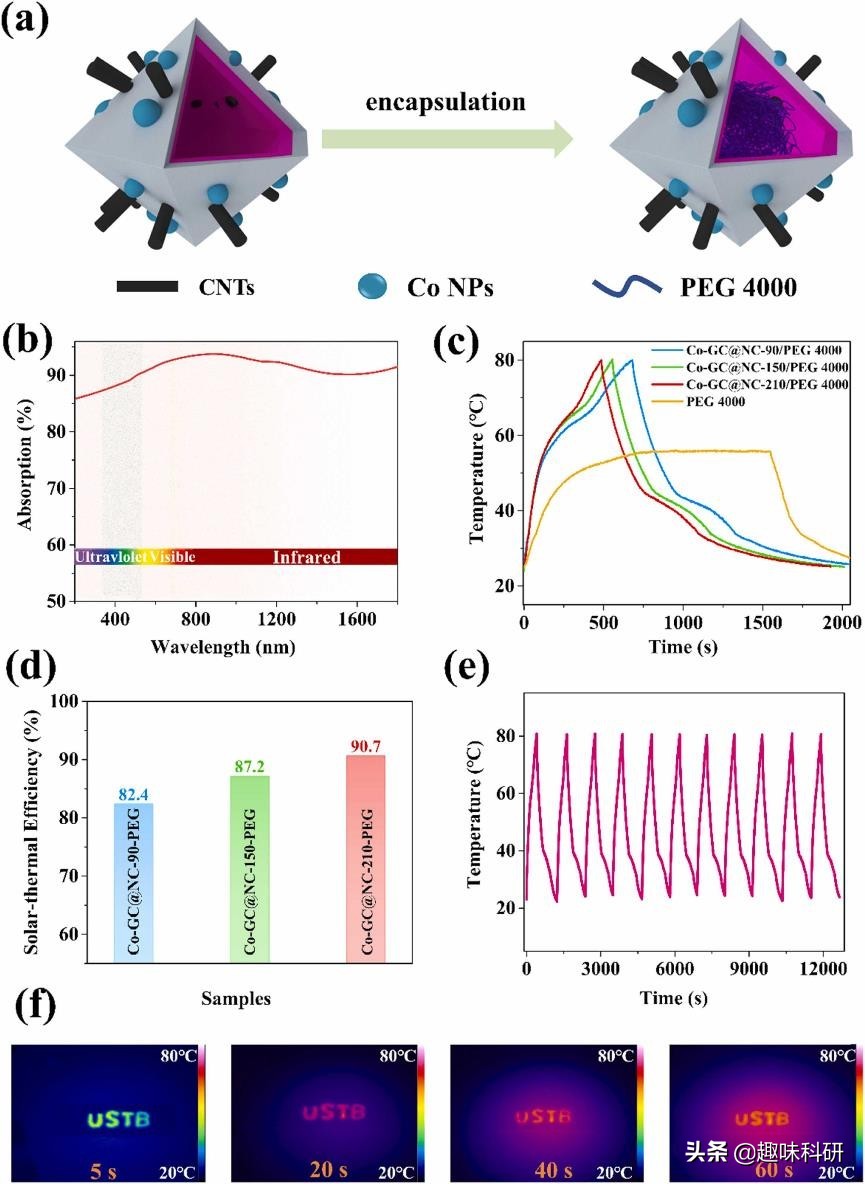
Figure 3. (a) Synthetic schematic illustration of Co-GC@NC/PEG 4000; (b) UV-Vis near-infrared absorption spectrum of Co-GC@NC; (c) solar-thermal energy conversion curves of PEG 4000, Co-GC@NC/PEG 4000 under solar simulator radiation; (d) The calculated solar-thermal energy conversion efficiencies (optical power intensity: 100 mW/cm2, radiated area: 1.27 cm2). (e) solar-thermal energy conversion curves of Co-GC@NC/PEG 4000 undergoing serval thermal cycles. (f) infrared images showing the temperature variations of the patterns of “USTB” under simulated sunlight illumination over time.
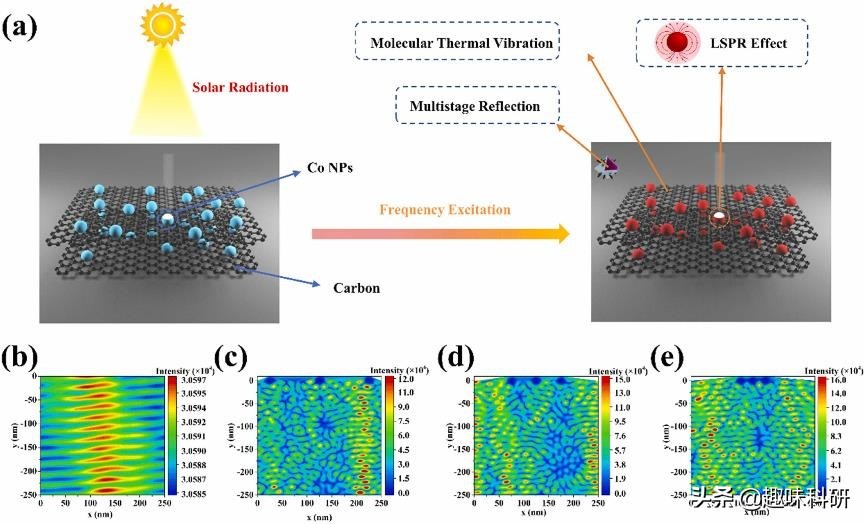
Figure 4. (a) Schematic illustration of solar-thermal energy conversion mechanism; Electric field distributions of (b) GC@NC, (c) Co-GC@NC-90, (d) Co-GC@NC-150, and (e) Co-GC@NC-210 on the plane.
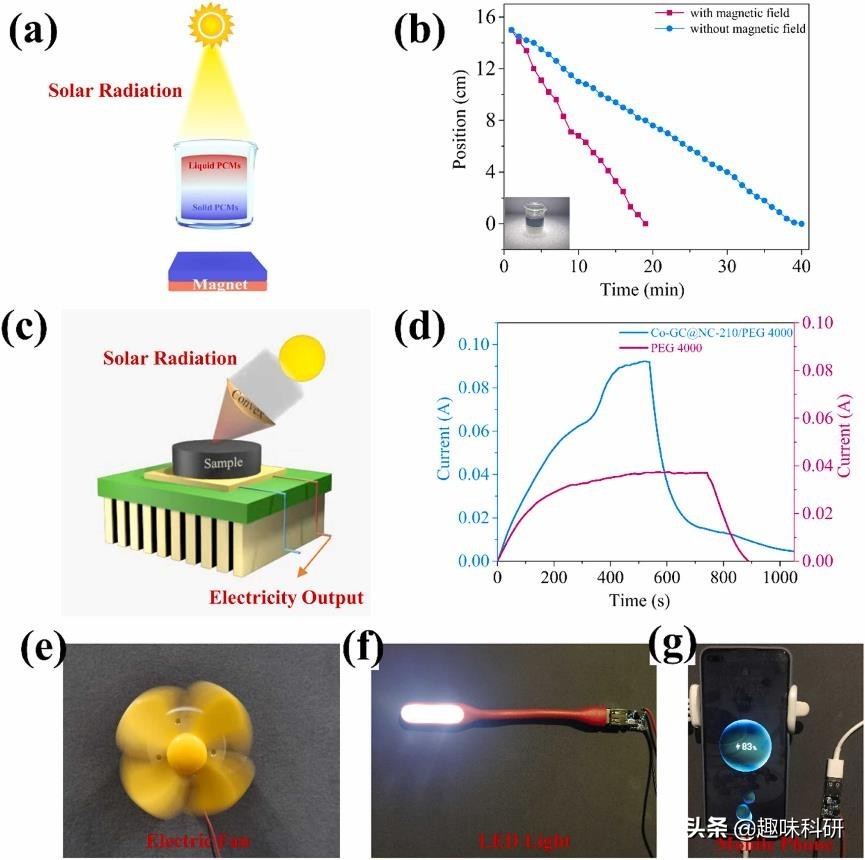
Fig. 5. (a) Schematic illustration of magnetically-accelerated solar-thermal energy conversion; (b) the change curves of the distance from solid-liquid interface of PEG 4000 to the bottom of the container over time, the inset is the experimental setup for solar-thermal energy conversion; (c) schematic illustration of solar-thermal-electric energy conversion; (d) output current of solar-thermal-electric energy conversion device with the duration of time; (e-g) solar-thermal-electric conversion device can directly power various electronic devices, including an electric fan, a LED, and a mobile phone.
【文章信息】
Authors: Zhaodi Tang, Yan Gao, Piao Cheng, Yu Jiang, Jianhang Xu, Xiao Chen, Ang Li, Ge Wang,
Title: Metal-organic framework derived magnetic phase change nanocage for fast-charging solar-thermal energy conversion,
Journal: Nano Energy,2022,107383,
https://doi.org/10.1016/j.nanoen.2022.107383.
